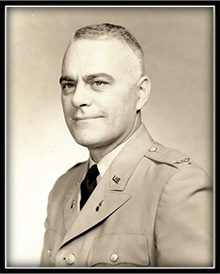Colonel Robert B. Braid
 Colonel Robert B. Braid was commissioned an Ord-nance Officer in 1940. He reported to Aberdeen Proving Ground (APG) on September 3rd, 1940 where he assumed command of the 151st Provision-al Ordnance Company. He would later serve as an assistant executive on the staff of the Ordnance School Commandant.
Colonel Robert B. Braid was commissioned an Ord-nance Officer in 1940. He reported to Aberdeen Proving Ground (APG) on September 3rd, 1940 where he assumed command of the 151st Provision-al Ordnance Company. He would later serve as an assistant executive on the staff of the Ordnance School Commandant.
Following his APG duties, he served in the Pacific Theater in 1944 and 1945 on the staff of the Commander in Chief (Chester W. Nimitz), U.S. Pacific Fleet. As assistant to the ground ordnance officer in the Combat Readiness Section, he planned the ammunition requirements for the Iwo Jima and Oki-nawa campaigns and the anticipated invasion of Japan.
His post-war assignments included three more years at APG, followed by a tour in Austria as an Ordnance officer. Following graduation from the U.S. Army War College he served as the deputy Post Commander at Watervliet where he was responsible for production planning, production engineering, procurement, and key inspection for all artillery for the army, as well as maintenance for reserve plants and mobilization planning.From there he assumed command of the U.S. Army Ordnance School, Eu-rope where he was responsible got consolidating the then Engineer and Ord-nance Schools in Europe. After this successful command he was transferred to the Watertown Arsenal where he assumed command in 1960. He led the arsenal in the research, engineering, development, manufacturing, and test-ing of various Ordnance items (Artillery, small arms, special munitions).
Colonel Braid culminated his career as the deputy project manager of the Nike-X project where he was responsible for all of the business aspects of the project (organization, management, and budget).
Colonel Braid's awards include the Legion of Merit.
Colonel Braid retired on June 30th, 1966 and passed away on November 24th, 1971.